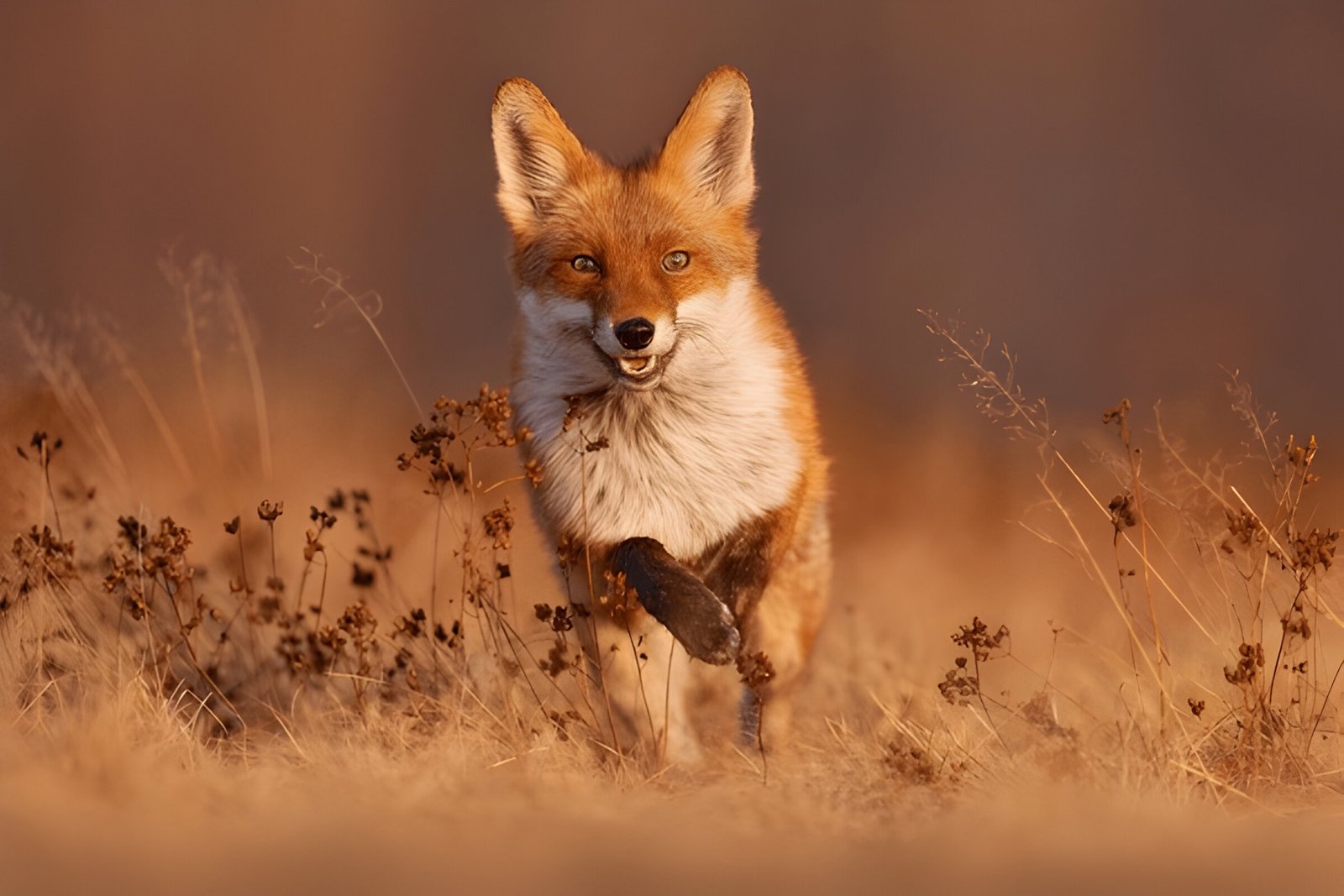Image Credit: ShutterStock
The mysterious sounds that pierce the night air often leave us wondering about their origins. Among these nocturnal calls, fox sounds at night stand out as some of the most intriguing and diverse. From haunting screams to eerie howls, these vocalizations have captivated human imagination for centuries, even finding their way into popular culture through shows like Midsomer Murders. Understanding these sounds not only satisfies our curiosity but also provides valuable insights into the behavior and communication of these elusive creatures.
This guide delves into the world of fox vocalizations, exploring the various types of sounds foxes make under the cover of darkness. It examines why foxes are so vocal at night and how to identify different fox species by their unique calls. The article also offers tips to distinguish fox sounds from those of other nocturnal animals, helping readers become more attuned to the natural symphony that unfolds after sunset. Whether you’re a wildlife enthusiast or simply curious about the sounds in your backyard, this comprehensive look at fox sounds at night will enhance your understanding of these fascinating creatures.
Common Types of Fox Vocalizations
Foxes have a diverse range of vocalizations, each serving a specific purpose in their communication. These nocturnal creatures produce an array of sounds that can be heard echoing through the night. Let’s explore some of the most common types of fox vocalizations.
Barks
Foxes, particularly red foxes, are known to bark. This sound is similar to that of a dog but has a distinctive quality. The bark of a fox is often described as hoarse and can be heard from a considerable distance. Gray foxes also make dog-like barking noises, which they use primarily for self-defense.
Screams
One of the most recognizable and chilling fox sounds at night is their scream. Red foxes produce a hoarse scream that can be mistaken for a human cry. Male red foxes use this piercing sound to warn off competing mates, while females emit short, shrill shrieks to attract males. These screams are so intense that they have been likened to the sound of a woman being murdered, leading to erroneous police call-outs.
Howls
Foxes also howl, adding to their nocturnal vocal repertoire. While not as common as barks or screams, fox howls contribute to the eerie symphony of nighttime sounds. These vocalizations help foxes communicate over long distances and can serve various purposes, such as territorial marking or locating other foxes.
Gekkering
A unique vocalization in the fox’s repertoire is “gekkering.” This sound is less commonly heard but is an integral part of fox communication. Gekkering is a rapid succession of low, guttural sounds often accompanied by high-pitched whines. Foxes use this vocalization during social interactions, particularly during play or mild aggression between individuals.
The Purpose Behind Nocturnal Fox Calls
Fox sounds at night serve various essential functions in their communication and social behavior. These vocalizations play a crucial role in their survival and reproduction strategies.
Territorial Marking
Foxes use their calls to establish and maintain territories. The “wow-wow-wow” bark is a common vocalization that serves as a declaration of territory ownership. This sound helps foxes to communicate their presence to other foxes in the area, effectively marking their territory without physical confrontation. In urban areas, where food is plentiful, territories can be as small as 0.2 square kilometers, while in more natural settings, they can extend up to 40 square kilometers.
Mating Rituals
During the breeding season, typically in spring, fox vocalizations take on a particular significance. The infamous scream, often mistaken for a human cry, is primarily used in mating contexts. Vixens (female foxes) emit short, shrill shrieks to attract males for mating. Males also produce screaming sounds to ward off competing mates. These vocalizations can last for up to 20 minutes during mating, functioning as a fox’s “love song.”
Warning Signals
Fox calls also serve as warning signals. Parent foxes with cubs use loud screams to warn off other foxes entering their territory, protecting their young. When foxes feel threatened or sense danger, they may scream to scare off predators. This vocalization is also used to alert other foxes of potential threats in the area. Additionally, foxes employ a warning bark that varies depending on their proximity to their den, helping others to pinpoint the location of danger.
Identifying Different Fox Species by Their Sounds
Red Fox
The Red Fox (Vulpes vulpes) is widely distributed across the northern hemisphere. These foxes have a diverse vocal repertoire, with adults producing 12 distinct sounds and kits making 8 different vocalizations. The most recognizable calls include barks, screams, and the unique “wow-wow-wow” contact call. Red foxes are known for their hoarse screams, which can be mistaken for a woman in distress. Male red foxes use these screams to warn off competitors, while females emit short, shrill shrieks to attract mates. During fights, red foxes can be quite noisy, producing loud screams, chatters, and squeals.
Gray Fox
The Gray Fox (Urocyon cinereoargenteus), also known as the “tree fox,” is native to North America. Unlike their red counterparts, gray foxes primarily make dog-like barking noises, which they use for self-defense. These foxes have a unique ability to climb trees due to their semi-retractable claws. Gray foxes typically range from 2 to 3 feet in length, with an additional 15-inch tail. They have a distinctive grizzled, salt-and-pepper fur with a black-tipped tail and white fur on their throats and bellies.
Arctic Fox
The Arctic Fox (Vulpes lagopus) inhabits the coldest regions of the world, including the Aleutian Islands of Alaska and the eastern border of Canada. While specific vocalizations of the Arctic Fox are not detailed in the provided information, these small carnivores have adapted to their harsh environment. They possess a white or blue-gray coat for camouflage in snowy landscapes, furry soles for insulation against freezing ground, and a thick coat to withstand extreme cold. Their vocalizations likely serve similar purposes to those of other fox species, such as communication and territory marking.
How to Distinguish Fox Sounds from Other Nocturnal Animals
Distinguishing fox sounds from other nocturnal animals can be challenging, but with careful observation and knowledge, it becomes easier. Foxes have a diverse vocal repertoire, including barks, screams, and howls. Their most distinctive sound is a shrill scream that can be mistaken for a human in distress. This vocalization is particularly common during mating season and can be heard up to five kilometers away.
Coyotes
Coyotes, often confused with foxes, have a more extensive vocal range. They’re known as “song dogs” due to their varied sounds, including growls, huffs, barks, howls, yelps, whines, and yodels. Coyotes are more likely to howl in groups, creating a chorus-like effect. Their vocalizations tend to be lower-pitched and more varied than those of foxes.
Owls
Barn owls produce a rasping, harsh scream that can be mistaken for a fox’s call. However, owl sounds are typically more consistent and repetitive. Barred owls, which have adapted to urban environments, have a distinctive “who-cooks-for-you” call. Unlike foxes, owls are more likely to make sounds while stationary or in flight, rather than during ground-level interactions.
Raccoons
Raccoons, though not typically associated with vocal behavior, can produce a range of sounds. Their vocalizations include chirps, squeaks, growls, hisses, and whines. When agitated, raccoons can emit a high-pitched shriek similar to a pig’s squeal. During fights, they produce sounds that have been likened to horror-movie torture scenes. However, raccoon vocalizations are generally less frequent and lower in volume compared to fox calls.
Conclusion
Fox sounds at night offer a captivating glimpse into the hidden world of these elusive creatures. From haunting screams to eerie howls, these vocalizations play a crucial role in fox communication, serving to mark territories, attract mates, and warn of potential dangers. Understanding these sounds not only satisfies our curiosity but also deepens our connection to the natural world around us.
As we’ve explored, different fox species have their own unique vocal signatures, adding to the rich tapestry of nocturnal sounds. By learning to distinguish fox calls from those of other night-time animals, we can better appreciate the complex ecosystem that comes alive after dark. This knowledge allows us to become more attuned to the natural symphony unfolding in our backyards and wilderness areas, fostering a greater respect for the wildlife that shares our environment.
Also Read: fox 2 news anchor husband dies
FAQs
- What is the significance of foxes making noises at night?
-
- Foxes vocalize at night primarily to mark their territory. Male foxes emit screams to warn off potential competitors and to deter predators, thereby protecting their young.
- Can you explain the meanings behind different fox vocalizations?
-
- Different fox sounds serve various purposes: Male red foxes emit noises akin to a woman’s scream to ward off rivals. Female red foxes use short, sharp shrieks to attract males. Gray foxes produce barking sounds as a defensive mechanism.
- During which time of the year are fox screams most commonly heard?
-
- Fox screams are most commonly heard during their mating season, which occurs in December and January. This is a normal behavior, although it can sound quite distressing.
- What are some effective fox call sounds for attracting them?
-
- Effective fox call sounds include the Wail n’ Woodpecker, Titmouse Tantrum, and Ranting Red Bird. These high-pitched sounds are particularly enticing to red foxes, especially when played continuously at a medium volume during calm conditions.













[…] […]
[…] […]